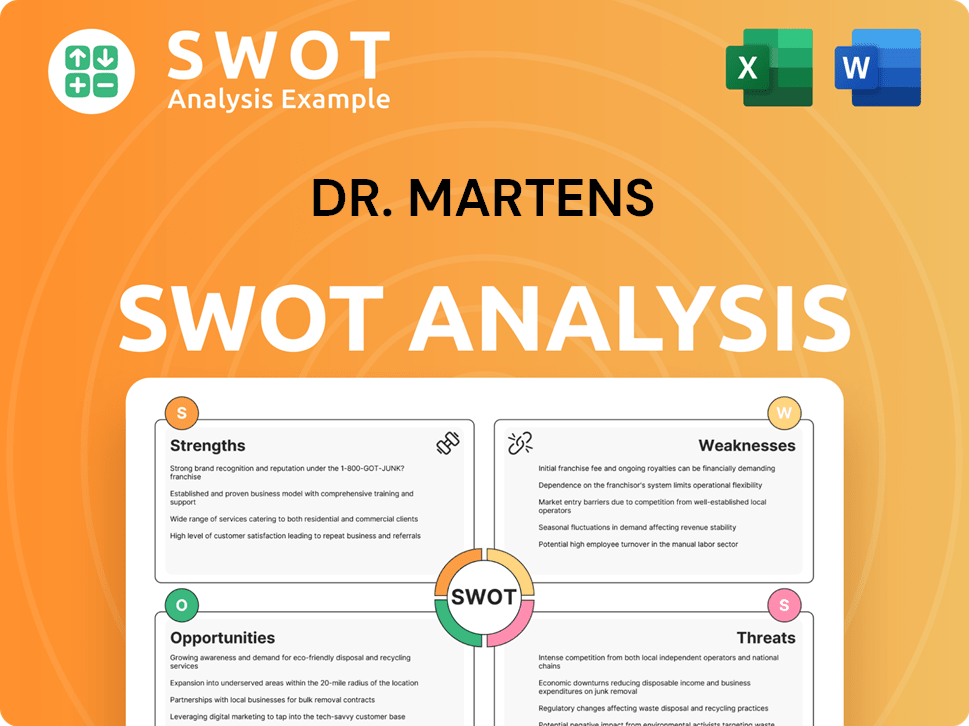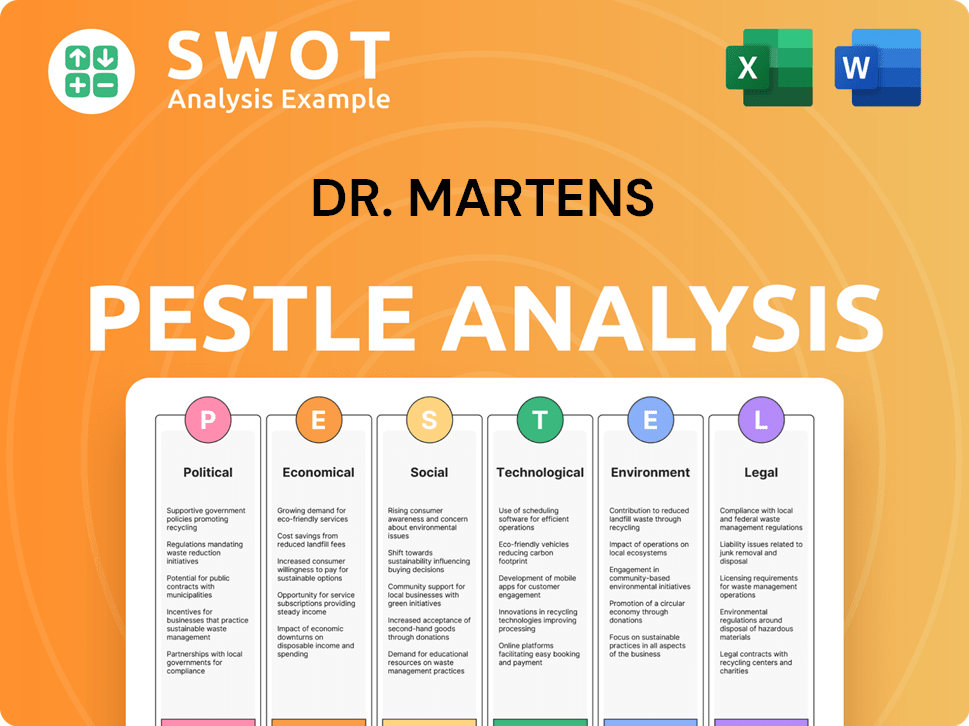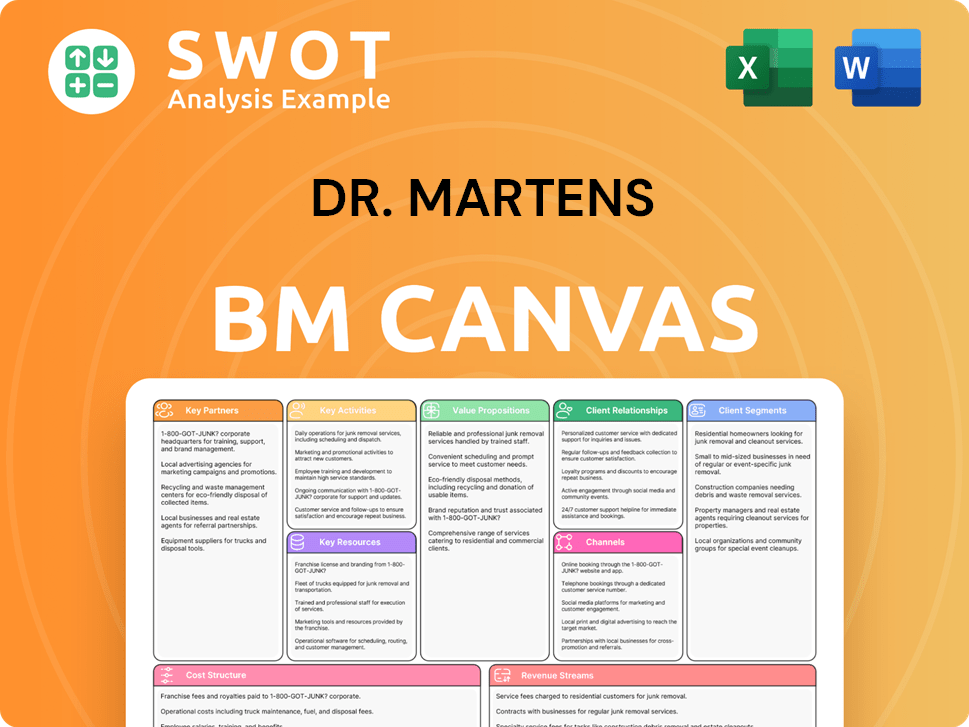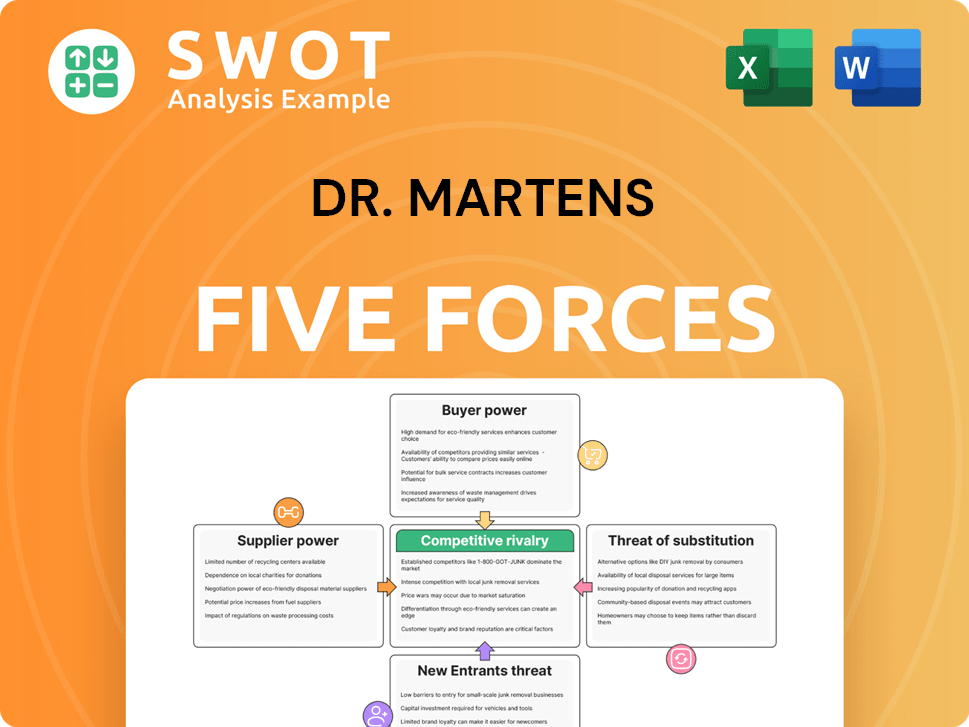Dr. Martens Bundle
Can Dr. Martens Rebound After a Sales Slump?
From its humble beginnings as a work boot to its iconic status in youth culture, Dr. Martens has a rich history. But recent financial headwinds, including a significant sales decline, have forced the brand to rethink its approach. This analysis dives deep into the Dr. Martens SWOT Analysis to understand its current sales and marketing strategies.

This exploration will dissect Dr. Martens' evolving sales strategy, including its digital marketing strategy and retail sales tactics, as it aims to reignite growth. We'll examine how the brand is targeting its customer base, from its core demographic to new market segments, and the effectiveness of its recent advertising and customer engagement efforts. Furthermore, we'll analyze Dr. Martens' brand strategy, brand positioning strategy and marketing mix elements to understand how it plans to recapture its market share and solidify its future, including its global marketing approach and customer loyalty programs.
How Does Dr. Martens Reach Its Customers?
The sales strategy of Dr. Martens is multifaceted, utilizing wholesale, retail, and e-commerce channels. The company is shifting from a channel-first to a consumer-first strategy, aiming for a more tailored distribution approach. This evolution is driven by the need to adapt to market dynamics and optimize sales performance across different regions.
Dr. Martens's marketing strategy is evolving to enhance its brand presence and customer engagement. The company is focusing on reducing discounting, especially in the Americas and EMEA, to reinforce its premium brand positioning. This strategic shift is part of a broader effort to drive full-price sales and improve profitability.
The brand's approach involves a blend of direct-to-consumer (DTC) channels, including e-commerce and physical retail, alongside wholesale partnerships. This multi-channel strategy allows Dr. Martens to reach a wide audience while maintaining control over its brand image and customer experience. The company is also exploring new growth markets with capital-light distribution models.
Historically, Dr. Martens has relied heavily on wholesale partners. However, due to overreliance on discounting, particularly in the Americas, wholesale revenue decreased. In FY2024, wholesale revenue in the Americas plummeted by 28.3%. The company is now recalibrating its strategy to reduce this dependency.
The DTC channel, encompassing e-commerce and physical retail, has shown resilience. In FY2024, DTC sales increased by 2.4%. This growth was driven by strong performances in EMEA and APAC, despite challenges in the US market. The company is investing in digital marketing and enhancing customer experience.
E-commerce sales reached £276.3 million in FY2024, a slight decrease of 1.0%, but with growth in all regions except the US. Dr. Martens aims to double its online sales to £140 million by the end of 2024. This expansion is supported by investments in digital marketing and improved online customer experience.
Retail sales increased by 6.2% to £256.8 million in FY2024. This growth was driven by a recovery in footfall in EMEA and APAC, offsetting declines in the US. As of November 2024, the company operated 238 stores globally, opening 10 new locations while closing 11.
Dr. Martens is focusing on reducing discounting across both e-commerce and wholesale channels, particularly in the Americas and EMEA. This strategy aims to boost full-price sales and reinforce its premium brand positioning. The company is also exploring new growth markets with capital-light distribution models to expand its reach.
- Reduce discounting to increase profitability.
- Invest in digital marketing and enhance the online customer experience.
- Expand into new markets with capital-light distribution models.
- Focus on a consumer-first strategy.
For a deeper understanding of the brand's target audience, consider reading about the Target Market of Dr. Martens.
Dr. Martens SWOT Analysis
- Complete SWOT Breakdown
- Fully Customizable
- Editable in Excel & Word
- Professional Formatting
- Investor-Ready Format

What Marketing Tactics Does Dr. Martens Use?
The marketing tactics employed by Dr. Martens are currently undergoing a significant shift, transitioning from a storytelling approach to a product-focused strategy. This change aims to build awareness, generate leads, and ultimately drive sales, especially in the challenging US market. This new approach, initiated in July 2024, is a key element of the overall Growth Strategy of Dr. Martens.
The updated marketing strategy emphasizes the unique product attributes that define the brand, such as the yellow stitch, grooved sole, and heel loop. This focus is intended to resonate with the Dr. Martens target market and highlight the brand's distinctive features. The goal is to boost customer engagement and drive sales through targeted advertising and in-store promotions.
Digital marketing plays a crucial role in the updated strategy, with 'always-on' campaigns for iconic styles like the 1460 boot. The company is investing in digital marketing to enhance its online presence and customer experience, focusing on lower-funnel spending to drive conversions. This approach is particularly important as the digital landscape adapts to evolving privacy regulations and the phasing out of third-party cookies.
The company is heavily investing in digital marketing strategies. This includes targeted e-commerce ads and in-store promotions to drive conversions. The focus is on enhancing online presence and improving customer experience.
In March 2025, Dr. Martens selected Amperity to support global data and marketing operations. This platform uses AI-powered identity resolution for consistent customer engagement. The goal is to provide personalized experiences across all channels.
Dr. Martens engages in community involvement and partnerships. A 2023 campaign featured over 500 artists globally, allowing customers to customize footwear. Limited-edition collaborations increased revenue by 15% year-over-year in 2023.
The company is committed to fostering a strong community presence. The aim is to achieve a 20% increase in community engagement initiatives in 2024. This highlights the importance of building brand loyalty.
The marketing strategy emphasizes the unique product attributes. This approach includes highlighting the yellow stitch, grooved sole, and heel loop. The focus is on driving sales through product-centric campaigns.
The digital industry is adapting to evolving privacy regulations. The approaching end of third-party cookies is a key factor. The company is adjusting its digital marketing strategies accordingly.
The current marketing strategy of Dr. Martens focuses on several key tactics to enhance brand awareness and drive sales. These tactics include a shift to product-focused campaigns, leveraging digital marketing, and fostering community engagement.
- Product-Focused Campaigns: Emphasis on unique product attributes like the yellow stitch and grooved sole.
- Digital Marketing: 'Always-on' campaigns, targeted e-commerce ads, and in-store promotions.
- AI-Powered Customer Engagement: Utilizing Amperity for consistent and personalized customer experiences.
- Community Involvement: Partnerships and collaborations to drive consumer engagement and brand loyalty.
- Global Marketing Approach: Adapting to evolving privacy regulations and the end of third-party cookies.
Dr. Martens PESTLE Analysis
- Covers All 6 PESTLE Categories
- No Research Needed – Save Hours of Work
- Built by Experts, Trusted by Consultants
- Instant Download, Ready to Use
- 100% Editable, Fully Customizable

How Is Dr. Martens Positioned in the Market?
The brand positioning of Dr. Martens, a key element of its Growth Strategy of Dr. Martens, centers on individuality and self-expression. Historically, the brand has been associated with rebellion and authenticity, attracting diverse customer segments who use its footwear to express their unique attitudes. This core message is reinforced through visual elements like the yellow stitching and air-cushioned sole, creating a strong brand identity.
However, Dr. Martens is evolving its brand positioning. The company is shifting from 'rebellious self-expression' to 'With Bouncing Soles,' emphasizing comfort, craft, and confidence. This strategic move aims to broaden its appeal and attract a wider consumer base by focusing on product benefits that resonate with them.
This shift acknowledges the limitations of solely relying on boots and a direct-to-consumer (DTC) approach for customer acquisition. The brand aims to reinforce its premium positioning through elevated collections and managing key product lines to optimize newness across various wearing occasions. Despite financial challenges, the brand maintains a premium price point, indicating strong consumer loyalty.
Dr. Martens' brand is rooted in a rich heritage that began with its working-class origins. This historical association has shaped its identity, making it a symbol of authenticity and rebellion. This strong foundation has allowed the brand to resonate with diverse groups, solidifying its place in fashion and culture.
The brand is now broadening its appeal by shifting from 'rebellious self-expression' towards 'With Bouncing Soles.' This new positioning will be built on the pillars of 'comfort, craft, and confidence.' This strategic shift is designed to attract a wider consumer base and boost Dr. Martens sales strategy.
Dr. Martens maintains a premium price point, indicating strong brand value and consumer willingness to pay more than the category norm. This premium positioning is supported by elevated collections and strategic management of hero product families. This strategy is crucial for Dr. Martens marketing strategy.
The brand is committed to sustainability, aiming to reduce carbon emissions by 50% by 2030 and use 100% recycled or sustainably sourced materials by 2025. In 2023, sales in eco-friendly lines increased by 25%, reflecting consumer demand for sustainable options. This is a key element of Dr. Martens brand strategy.
Despite facing challenges, Dr. Martens continues to adapt its brand strategy. The company reported a 42.9% drop in pre-tax profits in FY2024. The brand's ability to maintain a premium price point and its commitment to sustainability are critical for future growth.
- 42.9% drop in pre-tax profits in FY2024.
- 25% increase in sales of eco-friendly lines in 2023.
- Target to reduce carbon emissions by 50% by 2030.
- Aim for 100% recycled or sustainably sourced materials by 2025.
Dr. Martens Business Model Canvas
- Complete 9-Block Business Model Canvas
- Effortlessly Communicate Your Business Strategy
- Investor-Ready BMC Format
- 100% Editable and Customizable
- Clear and Structured Layout

What Are Dr. Martens’s Most Notable Campaigns?
The sales and marketing strategies of Dr. Martens are centered on impactful campaigns designed to boost brand visibility and drive sales. These campaigns often focus on product features and collaborations to resonate with its target market. The brand's approach includes both product-focused initiatives and collaborative efforts, showcasing a dynamic strategy to maintain customer engagement and sales growth.
A key element of Dr. Martens' marketing strategy involves leveraging its iconic product features. The 'Boots like no other' campaign, launched in October 2024, is a prime example. This shift from storytelling to a product-centric approach is aimed at highlighting the brand's unique attributes and driving strong sales responses, especially during the autumn/winter season.
Dr. Martens also strategically uses collaborations with artists and influencers to boost its brand. In 2023, the brand engaged over 500 artists globally, enabling customers to customize their footwear. This approach has been successful, contributing to a 15% year-over-year increase in revenue from limited-edition collaborations, demonstrating its effectiveness in engaging customers and fostering brand loyalty. Read more about the company in Brief History of Dr. Martens.
Launched in October 2024, this campaign focused on the unique features of Dr. Martens boots. It aimed to drive sales and establish a consistent platform for the autumn/winter season. The campaign is a shift towards product-focused marketing.
In 2023, Dr. Martens collaborated with over 500 artists globally. This initiative allowed customers to customize their footwear, enhancing brand engagement. These collaborations contributed to a 15% increase in revenue from limited-edition products.
Dr. Martens is implementing a new marketing-centric plan in the US region. This plan includes an 'always-on' marketing approach for iconic styles. It involves revitalizing boot offerings for autumn/winter 2024.
The US marketing plan features four key seasonal boot stories to drive newness. These seasonal stories are designed to engage customers. These efforts aim to return the US direct-to-consumer business to positive growth.
Dr. Martens Porter's Five Forces Analysis
- Covers All 5 Competitive Forces in Detail
- Structured for Consultants, Students, and Founders
- 100% Editable in Microsoft Word & Excel
- Instant Digital Download – Use Immediately
- Compatible with Mac & PC – Fully Unlocked

Related Blogs
- What are Mission Vision & Core Values of Dr. Martens Company?
- What is Competitive Landscape of Dr. Martens Company?
- What is Growth Strategy and Future Prospects of Dr. Martens Company?
- How Does Dr. Martens Company Work?
- What is Brief History of Dr. Martens Company?
- Who Owns Dr. Martens Company?
- What is Customer Demographics and Target Market of Dr. Martens Company?
Disclaimer
All information, articles, and product details provided on this website are for general informational and educational purposes only. We do not claim any ownership over, nor do we intend to infringe upon, any trademarks, copyrights, logos, brand names, or other intellectual property mentioned or depicted on this site. Such intellectual property remains the property of its respective owners, and any references here are made solely for identification or informational purposes, without implying any affiliation, endorsement, or partnership.
We make no representations or warranties, express or implied, regarding the accuracy, completeness, or suitability of any content or products presented. Nothing on this website should be construed as legal, tax, investment, financial, medical, or other professional advice. In addition, no part of this site—including articles or product references—constitutes a solicitation, recommendation, endorsement, advertisement, or offer to buy or sell any securities, franchises, or other financial instruments, particularly in jurisdictions where such activity would be unlawful.
All content is of a general nature and may not address the specific circumstances of any individual or entity. It is not a substitute for professional advice or services. Any actions you take based on the information provided here are strictly at your own risk. You accept full responsibility for any decisions or outcomes arising from your use of this website and agree to release us from any liability in connection with your use of, or reliance upon, the content or products found herein.